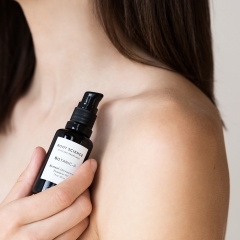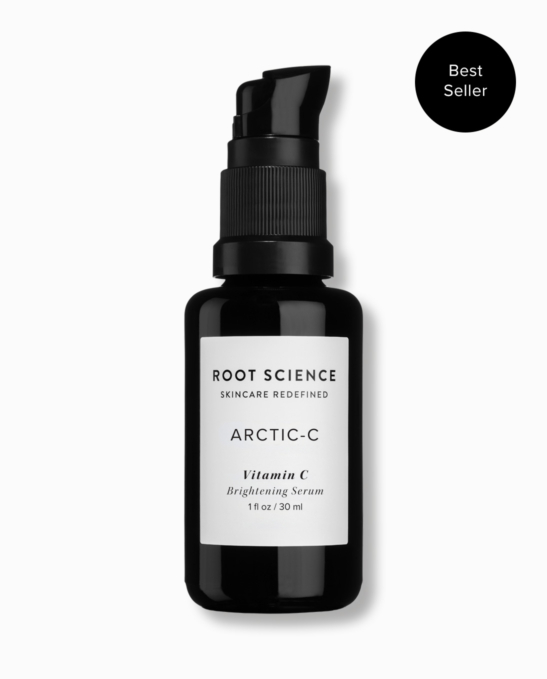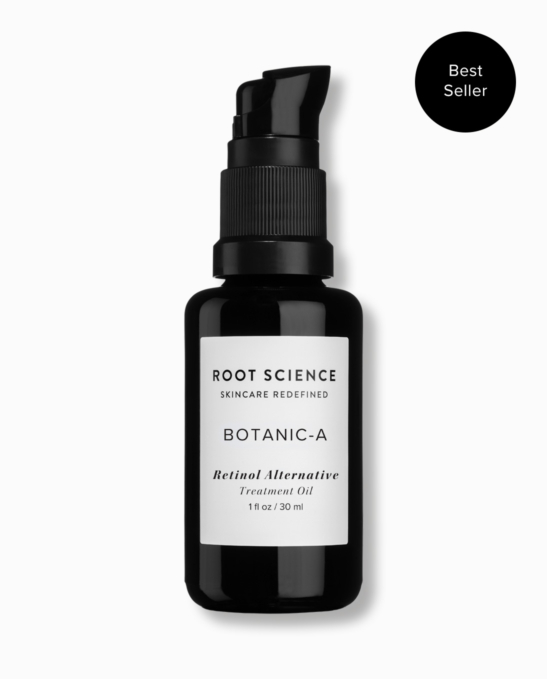If you’re looking for the best non-comedogenic oils for your skin, we’re here to point you in the right direction. And we won’t bore you by recommending cheap filler oils found in most formulas. We’ll review the best of the best, saving you from purchasing yet another disappointing face oil.
Face oils are having a major comeback due to their wealth of skin benefits. They are rich in skin beautifying nutrients that address numerous skin needs and concerns. But for many, the oil-free skincare marketing trend from the past is not so easily forgotten, influencing people’s purchasing behavior to this day.
This boom in face oils has curious skeptics asking: “which oils are non-comedogenic?” Or in simpler terms: “which face oils will not clog my pores?”
And we get it. Oil in skincare had a bad reputation for a while, mostly due to misinformed marketing. And those with oily and acne-prone skin have been repeatedly told to stay away from oil, which truth be told, isn’t the best advice. In fact, the right type of oil can be highly beneficial to those skin concerns.
Using the right type of oil can be the key to unlocking your best skin. So, it’s no wonder the once skeptics are slowly but surely turning into face oil lovers. Because once you find the right face oil for you skin, there’s no turning back. The results are that good!
In this blog we’ll cover the best non-comedogenic oils high in linoleic acid for all skin types, including acne-prone and oily. We’ll explain what non-comedogenic actually means, as well as review some the most common comedogenic oils that you should avoid. Your pores will thank you later!
What Does Non-Comedogenic Mean?
Non-comedogenic is a term used to describe cosmetic ingredients and skincare products that are less likely to clog pores.
This term is not standardized nor regulated by the FDA. And there are numerous factors that determine how an oil will interact with your unique skin, so there’s no guarantee that a non-comedogenic oil will work for you, however, it does serve as a helpful guide. For example, sunflower oil may work wonders for one person with acne-prone skin, but not for the next.
In addition to an oil’s comedogenic ranking, knowing the fatty acid composition will also help you to identify which oils are less likely to clog your pores. Skincare experts claim that oils high in linoleic fatty acid are generally less likely to clog pores. Keep reading to discover our favorite glow-inducing oils that are both non-comedogenic and high in linoleic acid.
Skin Benefits Of Oils High In Linoleic Acid
Each plant oil contains a unique mixture of fatty acids in various ratios. However, the two main types of fatty acids to consider when choosing the best non-comedogenic oil for your skin are linoleic and oleic acid. That’s because linoleic-rich oils tend to be non-comedogenic and oleic-rich oils are typically more comedogenic, increasing the chance for clogged pores.
Linoleic acid, also referred to as vitamin F, is highly prized for its numerous skin barrier benefits and affinity for most skin types, including dry, combination, oily and acne-prone.
Oils rich in linoleic acid are usually light-weight, absorb quickly and provide moisture without feeling greasy. They also help to promote a plump, smooth-looking complexion and leave your skin feeling incredibly soft. What’s not to love?
So, let’s review some of the best non-comedogenic oils, many of which are high in linoleic acid, that even those with oily and acne-prone skin can feel comfortable experimenting with.
The Comedogenic Scale
The scale in which oils are rated use a 0-5 range to indicate how comedogenic or likely the ingredient is to clog pores. Because everyone’s skin is different in the way it responds to ingredients, the comedogenic scale serves as a general reference point and guide. It should not be viewed as a fool proof system that guarantees skin compatibility. The comedogenic rating system simply helps you to differentiate between non-comedogenic oils or oils that are less likely to clog pores from comedogenic oils or oils that are more likely to clog pores.
0: will not clog pores
1: very low likelihood of clogging pores
2: moderately low likelihood of clogging pores
3: moderate likelihood of clogging pores
4: fairly high likelihood of clogging pores
5: highest likelihood of clogging pores

Skincare Powered By Science + Nature
Discover the one product your skin can’t live without.
The Best Non-Comedogenic Oils
1. Jojoba Comedogenic Rating 2
Regarded as a desert Island ingredient that does it all, jojoba is not actually an oil, but rather a liquid wax ester. But don’t let that scare you. Because of this, jojoba oil chemically resembles the oil our skin naturally produces and does not clog pores. Jojoba oil is biomimetic, functioning similar to human sebum (oil), making it nature’s perfect moisturizer.
Shop our favorite and most trusted authentic organic Jojoba oil here.
2. Rosehip Seed Oil Comedogenic Rating 1
This rosy red powerhouse of an oil is quickly rising in popularity due to its wealth of skin beneficial properties. Obtained from the seeds and skin of the rosehip fruit that grows on the rose bush (yes, rose bushes produce fruit), rosehip seed oil is considered a dry oil, sinking into skin effortlessly without clogging pores. Plus, it’s rich in omega-6 linoleic fatty acid and rejuvenating beta-carotene, also known as pro-vitamin A, along with corrective vitamin E and phytosterols.
Shop our favorite and most trusted authentic organic Rosehip oil here.
3. Grape Seed Oil Comedogenic Rating 1
Who would have guessed that a byproduct of the wine industry would end up being an A-list player in your skincare routine? Grape seed oil is one of the best non-comedogenic oils that’s also high in linoleic acid, with a whopping average of 70% omega-6 linoleic acid, making it ideal for oily, acne-prone or anyone prone to clogged pores. Grape seed oil is known for its sebum-regulating benefits and contains a plethora of skin nourishing antioxidants such as vitamin E.
4. Black Cumin Seed Oil Comedogenic Rating 2
This ancient ingredient is not one you find often in a facial oil formula, but trust us, it should be! Touted as a blemish antidote, black cumin oil has been used for thousands of years for its numerous benefits. It contains unique properties that help to create a hostile environment for blemishes, thus reducing the appearance of breakouts and promoting a clear-looking complexion.
5. Prickly Pear Seed Oil Comedogenic Rating 1
This rare and precious oil is extracted from the fruit from the prickly pear cactus. It’s prized for having the highest concentration of vitamin E compared to most plant oils. It’s also rich in protective antioxidants and revitalizing phytocompounds. It contains roughly 60% omega-6 linoleic acid and feels like silk when applied to the skin, promoting a distinct softness and glow.
6. Raspberry Seed Oil Comedogenic Rating 1
This iconic summer berry produces some of the freshest smelling and top performing non-comedogenic oil you could ask for. Plus, it’s abundant in omega-6 linoleic acid and omega-3 alpha-linoleic acid, making it ideal for sensitive skin. Raspberry seed oil acts as a potent antioxidant due to the presence of vitamin E and carotenoids. It’s rich in texture, so it’s best to look for a facial oil blend that includes this nutrient-rich oil.
7. Squalane Comedogenic Rating 0
This ultra-light, biomimetic oil is highly compatible with acne-prone and oily skin types. Plus, it helps to balance oil production. Squalane acts as an antioxidant, which means it provides protection against free-radicals and their negative effects on skin. Squalane is an emollient, providing excellent moisturizing benefits that help to dramatically soften and smooth skin.
Common Non-Comedogenic Oils
So now that we’ve reviewed some of the best non-comedogenic oils that deliver major skin benefits, let’s review some of the most commonly used oils that didn’t make our best of the best list. You’ll notice sunflower oil and safflower oil in many facial oil formulas. They are used as inexpensive filler oils to cut down on costs. Sunflower and safflower oil can be non-comedogenic, as long as they aren’t the high oleic type, which is why we don’t recommend them. You just can’t be sure that they are non-comedogenic, unless it’s stated. In addition, they do not offer significant benefits, beyond moisturizing. Due to the fact that these oils are mass produced for the food and cosmetic industry, they are often highly refined, which removes the skin beneficial vitamins and antioxidants that deliver results.
Comedogenic Oils AKA Pore-Clogging Oils
Below we list some common comedogenic oils aka pore clogging oils that we don’t recommend using undiluted on the face. However, just because an oil has a high comedogenic rating doesn’t necessarily mean you can’t benefit from it. Many times, these oils are used in a blend that minimizes the overall chance of clogged pores.
Coconut Oil
Avocado Oil
Apricot Kernel Oil
Castor Oil
Cocoa Butter
Palm Kernel Oil
Soybean Oil
Frequently Asked Questions About Non-Comedogenic Oils
Is Marula Oil Comedogenic?
Marula oil has a comedogenic rating of 3-4. This means that it is very likely to clog pores. It also contains on average 70-80% oleic acid, which further explains why many people who are oily and acne-prone find that marula oil is not compatible with their skin. It is better suited for dry and mature skin.
Is Sunflower Oil Comedogenic?
There are several types of sunflower oil available. High oleic sunflower oil is comedogenic, meaning it is very likely to clog pores. High linoleic sunflower oil is non-comedogenic, so it is less likely to clog pores. High oleic sunflower oil is frequently used due to the fact that it is more stable. Therefore, sunflower oil’s comedogenic rating will vary depending on the type of oil being used. If you want to be certain which type of sunflower oil is used in a facial oil blend, it’s best to reach out to the seller.
Is Rosehip Seed Oil Comedogenic?
Rosehip oil has a comedogenic rating of 2, generally speaking. Just as there are varying varieties and grades of olive oil, the same goes for cosmetic oils. If rosehip oil is obtained only from the seeds of the fruit, then typically it will be higher in linoleic acid. If the oil is obtained from a blend of the seeds and skin, it can have a slightly lower linoleic acid value. Because rosehip oil is in high demand and expensive to produce, the market is flooded with low-quality, adulterated versions that are often cut with a cheaper oil that may be high in oleic acid, which will increase the comedogenic rating. We recommend opting for a high-quality source of rosehip oil to truly experience all of its amazing skin benefits. If you find rosehip oil that is yellow or very light in color, there’s a high probability that it’s adulterated. Rosehip oil is fragile and it can quickly become rancid. For this reason, we recommend avoiding packaging that uses droppers, as they introduce air each time you use the product. We also recommend finding a facial oil blend that’s designed to stabilize the more fragile oils high in linoleic acid, such as rosehip oil. At Root Science, we use a superior quality rosehip oil that’s strategically blended with stable, antioxidant-rich oils for optimal freshness and potency, found in our Restore serum.
Is Olive Oil Comedogenic?
Olive oil is non-comedogenic and has a comedogenic rating of 2. It should be noted that the quality and extraction method plays a major role in determining how well your skin responds to olive oil. Extra virgin olive oil that is cold-pressed and unrefined is best for skin because it’s rich in protective antioxidants and corrective polyphenols. It’s also high in oleic acid, so we do not recommend it for oily or acne-prone skin. However, dry and mature skin types may benefit from topical application of olive oil. It is best to find a face oil that blends olive oil with oils high in linoleic acid.
The Bottom Line
The comedogenic rating system can help guide you in the process of finding the best oil for your skin. However, it’s up to you to experiment to find the perfect fit. Your skin is unique, and so is the way it responds to ingredients. Enjoy the process!
Shop Featured Products
Disclaimer: This content is for informational and educational purposes only. It is not intended to provide medical advice or to take the place of such advice or treatment from a personal physician. All readers/viewers of this content are advised to consult their doctors or qualified health professionals regarding specific health questions. Neither Root Science nor the publisher of this content takes responsibility for possible health consequences of any person or persons reading or following the information in this educational content. All viewers of this content, especially those taking prescription or over-the-counter medications, should consult their physicians before beginning any skincare, nutrition, supplement or lifestyle program. The views and products expressed are not intended to treat, cure or prevent any disease.
Image Sources: Image via Annie Spratt



